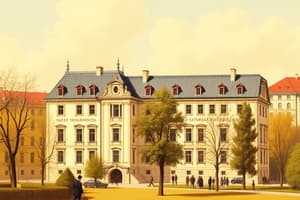Podcast
Questions and Answers
The Classical era has been called The Age of Reason.
The Classical era has been called The Age of Reason.
True (A)
The four musical masters of the Viennese school are:
The four musical masters of the Viennese school are:
- Bach, Haydn, Mozart, and Schubert.
- Haydn, Mozart, Beethoven, and Brahms.
- Haydn, Mozart, Beethoven, and Schubert. (correct)
How is Classical harmony best described?
How is Classical harmony best described?
diatonic
Classical composers often incorporated folk elements in their music.
Classical composers often incorporated folk elements in their music.
Jacques-Louis David was a German early Romantic poet.
Jacques-Louis David was a German early Romantic poet.
Two authors associated with the Sturm und Drang movement of the 1770s were:
Two authors associated with the Sturm und Drang movement of the 1770s were:
How is Classical phrase structure best described?
How is Classical phrase structure best described?
What musical occupation was LEAST available to women in the Classical era?
What musical occupation was LEAST available to women in the Classical era?
How is Classical melody best described?
How is Classical melody best described?
The Industrial Revolution of the eighteenth century saw a series of important inventions, which helped shape the modern world.
The Industrial Revolution of the eighteenth century saw a series of important inventions, which helped shape the modern world.
Two significant historical events that occurred during the Classical era were the French and American Revolutions.
Two significant historical events that occurred during the Classical era were the French and American Revolutions.
Which concert venues were available to composers of the Classical era?
Which concert venues were available to composers of the Classical era?
The eighteenth-century composer was most likely to find a patron in:
The eighteenth-century composer was most likely to find a patron in:
How is Classical texture best described?
How is Classical texture best described?
Viewing life rationally and striving to 'see life as a whole' were approaches taken by:
Viewing life rationally and striving to 'see life as a whole' were approaches taken by:
Which period of European art and literature most captivated eighteenth-century thinkers?
Which period of European art and literature most captivated eighteenth-century thinkers?
How is Classical meter best described?
How is Classical meter best described?
Flashcards are hidden until you start studying
Study Notes
Classical Era Overview
- The Classical era is dubbed The Age of Reason, reflecting a focus on rational thought and clarity in art and philosophy.
- Significant historical events during this period include the French and American Revolutions, which shaped societal structures.
Viennese School
- The four musical masters of the Viennese school are Haydn, Mozart, Beethoven, and Schubert, known for their significant contributions to classical music.
Musical Characteristics
- Classical harmony is primarily diatonic, emphasizing the importance of the scale and its chords.
- Classical phrase structure is characterized by regularity and symmetry, highlighted by clear cadences, providing a sense of resolution.
- The texture of classical music is largely homophonic, allowing a single melody to stand out against accompanying harmonies.
- Classical melodies are described as elegant and singable, making them memorable and accessible.
Folk and Cultural Influences
- Composers in the Classical era often integrated folk elements into their works, reflecting the diverse cultural influences surrounding them.
- The Sturm und Drang movement in the late 18th century, connected to writers Goethe and Schiller, emphasized emotional expression and individualism.
Women's Opportunities
- In the Classical era, orchestral conducting was the least accessible musical occupation for women, despite other roles like professional singer, instrumentalist, and music teacher being available.
Concert Venues and Patronage
- Composers had access to various concert venues in the Classical era, including royal palaces and concert halls, which fostered public performances.
- The aristocracy was the primary source of patronage for composers, supporting their artistic endeavors financially.
Meter and Modernization
- Classical meter is defined as regular and strong, contrasting with more fluid and weak rhythms found in other musical periods.
- The Industrial Revolution of the eighteenth century initiated a wave of inventions that transformed society and influenced artistic expression.
Philosophical Trends
- Classicists viewed life rationally, striving to understand existence as a coherent whole, setting a foundation for the values of the era.
- Eighteenth-century thinkers were particularly captivated by the Greek and Roman periods (antiquity), inspiring a revival in classical ideals and aesthetics.
Studying That Suits You
Use AI to generate personalized quizzes and flashcards to suit your learning preferences.



